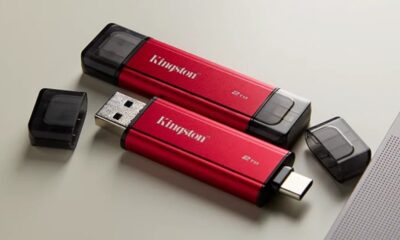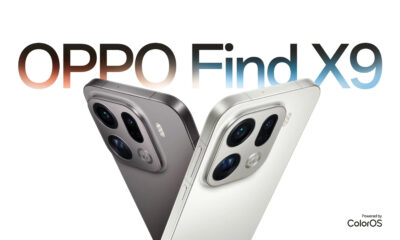VAR
Samsung Galaxy Z Fold6 vs Google Pixel 9 Pro Fold: Clash Of The Folding Phenoms
Foldables belong to a niche category of the flagship smartphone segment. These cutting-edge, dual-screened gadgets are reserved for the ones willing to spend considerably more than what a regular (still expensive) flagship like the iPhone 15 Pro Max or Samsung Galaxy S24 Ultra costs. The Samsung Galaxy Z Fold6 and Google Pixel 9 Pro Fold are two of the latest and greatest entrants into this elite arena. They are the most advanced embodiments of the foldable smartphone tech, flaunting thinner bodies, larger screens, and sturdier, more efficient hinges. So then, which of these state-of-the-art, futuristic pieces of consumer tech is the best? Moreover, which one would suit your needs the best? Find out in this in-depth Samsung Galaxy Z Fold6 vs Google Pixel 9 Pro Fold comparison.
Samsung Galaxy Z Fold6 — The Trailblazer Of Foldable Smartphones
Ever since its inception, the Samsung Fold series has played a pivotal role in popularizing foldable smartphones. The Galaxy Z Fold6 is the latest heir of this innovative bloodline. The Fold6 sports a squared-off design compared to the more rounded-off aesthetics of its immediate predecessor. Upgrades underneath its skin are incremental and there isn’t much to be super-excited about, except for the new AI features. However, Samsung has strengthened the dual rail hinge of the Fold6 with a more rigid folding edge, which they claim is better at distributing the shock of external impacts. While we see that smartphone hardware is generally evolving at a slower pace, it is actually satisfying to know that Samsung putting in significant effort to make their foldables more durable. While the Fold6 shares all other technological aspects with regular smartphones, including performance and cameras, enhancing and upgrading the foldable components, seems like the right move. On top of that, the more squarish design doesn’t just deliver sleeker aesthetics but also provides a better in-hand feel, thus enhancing the user experience.

Keeping the tech aspects apart, from a user perspective, the Fold6 is the most polished iteration of the Fold series, not simply because it’s the latest but because of the re-proportioning of the design. The cover screen is now slightly wider, and less like a TV remote, and the weight has come down by around 14 grams compared to the Fold5. Another groundbreaking upgrade is on the ingress protection front. While the previous Fold models were limited to only water resistance, the Fold6 offers IP48 dust and water resistance. In simple words, the 4 in the rating ensures that no particles larger than 1 mm can enter the device. As it happens every year, the chipset has been upgraded to the latest in the market. Powering the Fold6 is the best of Android chipsets, the Snapdragon 8 Gen 3. Other than these significant upgrades, the Fold6 mostly matches its predecessor’s hardware components including camera hardware, battery size, and charging speeds.
Google Pixel 9 Pro Fold: The Vanilla Foldable Experience
Software experience is the paramount strong point of any Pixel phone. However, that isn’t only how the first Pixel Fold amazed us. Google’s first foldable was a well-proportionate device in terms of screen real estate. However, these user advantages were overshadowed by some of the disadvantages of the design itself. The Pixel Fold was too bulky to deliver the goodness of the proportionate screen during prolonged usage. On top of that, the original Pixel Fold didn’t open or fold flat, which further took away from the user experience, when compared to the more refined competitor of the time — the Samsung Galaxy Z Fold5. However, for a first-generation foldable, it can undeniably be said that the Pixel Fold was a superlative product.
Recently, Google introduced the successor to the original Fold, along with the Pixel 9 series. Now called the Google Pixel 9 Pro Fold, a name that aligns better with the current flagship lineup, the new folding smartphone is seemingly leaps and bounds ahead of its predecessor. For starters, the new phone is taller and slimmer, while the fluid-friction hinge has been upgraded for increased durability and delivering a satisfying snap when the phone is opened. Both the displays are now larger, delivering a more immersive user experience. The cover screen has grown from a 5.8-inch unit with a peak brightness of 1,550 nits in the previous FOld to a 6.3-inch unit with a peak brightness of 2,700 nits. The larger inner screen of the Pixel Fold measured 7.6 inches diagonally (1,450 nits peak brightness) which is now upgraded to a massive 8-inch unit (2,700 nits peak) in the Pixel 9 Pro Fold.

The Pixel 9 Pro Fold has also gained a superior ultra-wide lens which now features a larger sensor, offering 127 degrees of truly “ultra-wide” coverage. Furthermore, both the front cameras (cover screen and inner screen) have been upgraded to the same 10 mp shooter. On the battery front, it is surprisingly a downgrade from the 4,821 mAh unit of the original Pixel Fold to a 4,650 mAh cell in the 9 Pro Fold. However, as Google is a smartphone company focused primarily on software experience and optimization, we’ll have to test the phone out extensively to determine whether the downsizing has inversely affected the battery life or ended up boosting it. These are the groundbreaking upgrades Google has bestowed upon the Pixel 9 Pro Fold, resulting in an all-encompassing redesign of their foldable. For a second-generation foldable, the Pixel 9 Pro is now up to the mark and capable of competing with the mighty Samsung. However, there is one major drawback, which we will address in the comparison.
Samsung Galaxy Z Fold6 vs Google Pixel 9 Pro Fold: So Then, Which Foldable Triumphs Over The Other?
It’s time for the battle now and firstly, let’s discuss similarities and keep them apart. Both the Samsung Galaxy Z Fold6 and Pixel 9 Pro Fold run Android 14 out of the box and are promised seven major updates. Both feature crisp and bright OLED displays inside out, although of different sizes and specs. Also, both the phones are equipped with three rear cameras each and a total of two front cameras, one on the cover screen and one inside. Now for the differences, I’ll lay them out sector by sector.
The Samsung Galaxy Z Fold6 Is The More Powerful One
Processing power is one of the central factors when it comes to the performance of any smart device or computer, including smartphones. The Samsung Galaxy Z Fold6 is powered by the latest and greatest processor from Qualcomm — the Snapdragon 8 Gen 3. The Pixel 9 Pro Fold on the other hand is invigorated by Google’s in-house Tensor G4 chipset. While both of these powerhouses are built on the 4 nm architecture, the Snapdragon 8 Gen 1 is far superior to the Tensor G4 in terms of sheer processing power and gaming performance.

According to tests conducted by NanoReview, the Snapdragon 8 Gen 3 performs 76% better in floating-point computation and shows up to 55% higher AnTuTu 10 benchmark scores. The 8 Gen 3 also supports 20% higher memory bandwidth (77 against 64 GB/s) and runs on a 6% higher CPU clock speed (3300 Vs 3100 MHz). On paper, the only pro in favor of the Google Tensor G4 over the Snapdragon is its higher GPU frequency (~22%). However, when tested out by NanoReview, the GeekBench compute score of the Adreno 750 GPU in the 8 Gen 3 completely obliterates the Mali-G715 of the Tensor G4. The Adreno 750 scored 14,269, which is around 148% higher than the 5,758 score of the Mali-G715.
This means that regardless of whether it is single-core, multicore, or GPU performance, the 8 Gen 3 is miles ahead of the Tensor G4. We hope the Tensor series to evolve into a more capable and potent chipset as its next iteration, the Tensor G5, is reportedly being built on TSMC’s 3 nm process. But as of now, it is no match to the mighty, Snap-py, Dragon.
The Pixel 9 Pro Fold Takes The Cake For The Software Experience
Google offers arguably the best Android user experience because the OS itself is made by Google in the first place. Hence, the vanilla Android experience provided by Google phones remains unmatched and unaffected by competitors. It is just so pleasantly designed, with the right amount of simplicity and vibrancy. There is absolutely zero bloatware, and it is exceptional to use in both screens of the Pixel 9 Pro Fold. And then there are the clever features Google has reserved for their own phones. These features such as Live Caption, Pixel Studio, Pixel Screenshots Circle To Search, and Now Playing, all contribute to delivering a superior user experience.

Although the latest Galaxy devices including the Fold6 come integrated with AI features, Google is simply better in terms of overall software experience. On top of all that, the latest range of Pixel phones, also offer a bunch of cool new Camera software trickery. The most prominent one is the “Add Me” feature which allows the photographer to be in the photo by combining two consecutive images together. The results of this AI feature are too good to be true, and it is just one example of the Pixel’s impressive software prowess.
Samsung Galaxy Z Fold6 vs Google Pixel 9 Pro Fold: Other Significant Hardware Differences
Apart from the processor, there are some other major hardware changes differentiating these foldables from each other. They are as follows –
Size, Convenience, And Protection: The Lighter One vs The Thinner One
The Samsung Galaxy Flip6 weighs in at 239 g whereas the Pixel 9 Pro Fold is heavier at 257 g. To put that into perspective, the iPhone 15 Pro Max weighs 221 grams, and the S24 Ultra 232 grams. So in comparison, the Flip6 is only marginally heavier, while the Pixel is considerably more hefty, which might affect day-to-day usability. On top of that, the Flip6 offers IP48 dust and water resistance, while the Pixel is limited to IPX4 water resistance. However, the Pixel is thinner and wider, both when folded and unfolded. The Pixel 9 Pro Fold has a thickness of only 10.5 mm when folded, against the 12.1 mm thickness of the Fold6.

Screens: The Pixel Offers More
The cover screens of both these phones measure 6.3 inches, with negligible differences in resolution and pixel density. However, the Pixel 9 Pro Fold has a wider aspect ratio and looks more regular against the longer structure of the Flip6. Similarly, the inner screen of the Pixel 9 Pro Fold is larger, measuring 8 inches diagonally, against the 7.6 inches provided in the Flip6. Both the inner and outer screens of the Pixel also boast a 100 nits higher peak brightness rating of 2700 nits.
Storage: Faster, Larger Storage Options vs Extra RAM
The Samsung Galaxy Z Fold6 offers up to 1 TB of fast UFS 4.0 storage, while the Pixel 9 Pro Fold is capped at 512 GB, that too, slower UFS 3.1. Conversely, the 9 Pro Fold offers up to 16 gigs of RAM, whereas the Flip6 is limited to 12.
Camera: 8K Video Recording vs Better Front Cameras
On the optics front, the Pixel 9 Pro Fold, as mentioned earlier, offers a wider ultra-wide lens — 127-degree coverage against 123 in the Fold6. The Fold6 retaliates by offering 8K video recording when the Pixel is limited to 4K. When it comes to front cameras, the Pixel 9 Pro Fold dominates by offering the same 10 MP camera with autofocus on both its screens. The Samsung, while incorporating a 10 MP camera onto the inner screen, is limited to a 4MP sensor in the cover screen, both of them without autofocus functionality.
Battery: Larger Battery vs Faster Charging
Keeping the Galaxy Fold6 alive is a 4,400 mAh battery pack that supports wired fast charging of up to 25 watts and wireless up to 15 watts. It further offers reverse wireless charging functionality, rated up to 4.5 watts. The Pixel 9 Pro Fold features a larger 4,650 mAh battery pack. However, its wired fast charging wattage hasn’t been revealed by Google yet, but we know that the wireless charging speed is rated at a mere 7.5 watts. Google just mentions “hours of power in minutes of charge with Google 45W USB-C Charger”, although multiple sources mention that the wired charging speed is capped at 21 watts.

Samsung Galaxy Z Fold6 vs Google Pixel 9 Pro Fold: Crowning the Foldable Champion
We have analyzed the specs and features of these two foldables in-depth and we conclude that we would prefer both of these devices; just for different usage styles. It might seem like the usual diplomatic answer, but hear me out. The Samsung Galaxy Z Fold6 is a more performance-oriented device, offering phenomenal processing power compared to the Pixel. The Google Pixel 9 Pro Fold, on the other hand, dominates on the software front with its clever tricks that are not just gimmicks but legitimately usable in daily life. Hence, you will have to make a choice based on your needs, preferences, and aesthetic taste. To help make your decision easier, here’s a simplified list of differentiating factors that set these two impressive foldable phones apart.
| Samsung Galaxy Fold 6 | Google Pixel 9 Pro Fold |
| Lighter | Thinner And Wider |
| Stronger Processor | Vanilla Android Experience |
| Dust Resistance / Ingress Protection | Larger, higher resolution screens with slightly higher brightness |
| Up to 1 TB Of UFS 4.0 Storage | Up to 16 GB RAM |
| Faster Charging Speeds | Larger Battery |
| 8K Video Recording | Higher-resolution front cameras |
VAR
Kingston launches Dual Portable SSD Storage Solution

Kingston Digital Europe Co LLP, the flash memory affiliate of Kingston Technology Company, Inc., a world leader in memory products and technology solutions, today announced it releases its first cable-free solid-state drive for those in need of an affordable and reliable, portable solution for data back-up and transfers.
With the sleek look of a traditional flash drive in a compact, durable metal casing, the Dual Portable SSD can easily transfer files between USB Type-A and USB-C devices such as laptops, desktops, mobile devices and more with USB 3.2 Gen 2 speeds up to 1,050MB/s read and 950MB/s write2. To improve productivity and enhance your workflow, this all-in-one storage and transfer solution boasts capacities up to 2TB for large files, high-res photos and 4K videos.
“More and more consumers are looking to take their data into their own hands,” said Liny Cheliyan, Business Manager – Prosumer Flash and SSD Kingston EMEA. “Now with the convenience of Kingston’s Dual Portable SSD, users can do just that and easily transfer, share or backup their important files across a variety of USB-A and USB-C devices.”
Dual Portable SSD is available in capacities3 512GB, 1TB, and 2TB and is backed by a limited five-year warranty5, free technical support, and legendary Kingston reliability. For more information visit kingston.com.
Kingston Dual Portable SSD Features and Specifications:
- Fits your life: All in one, and one for all…of your devices that is. With both USB-A and USB-C connectors, the Dual Portable SSD easily transfers files between your devices: laptops, desktop, mobile and more.
- The speed you need: Amplify your creative productivity with USB 3.2 Gen 2 speeds up to 1,050MB/s read and 950MB/s write2.
- Ditch the cable: Life is messy enough without the chaos of cable management. Keep it simple and go cable-free. Palm, pocket or purse, this compact and sleek SSD fits virtually anywhere.
- Store more, create more: Get reliable storage for your large files, high-resolution photos and 4K videos up to 2TB3.
- Interface: USB Type-A and USB Type-C
- Standard/Speed2: USB 3.2 Gen 2; Up to 1,050MB/s read, 950MB/s write
- NAND: 3D
- Capacities3: 512GB, 1TB, 2TB
- Dimensions: 71.85mm x 21.1mm x 8.6mm
- Weight: 13g
- Casing Material: Metal + Plastic
- Operating temperature: 0°C~60°C
- Storage temperature: -20°C~85°C
- Warranty/support4: Limited 5-year warranty with free technical support
- Compatible with5: Windows 11, macOS (v. 13.7.6 +), Linux (v. 4.4x +), Chrome OS, Android, iOS/iPadOS (v.13+)
VAR
OPPO Find X9 Pro In-Depth Review: Hasselblad Optical Excellence With Two-Day Battery Life
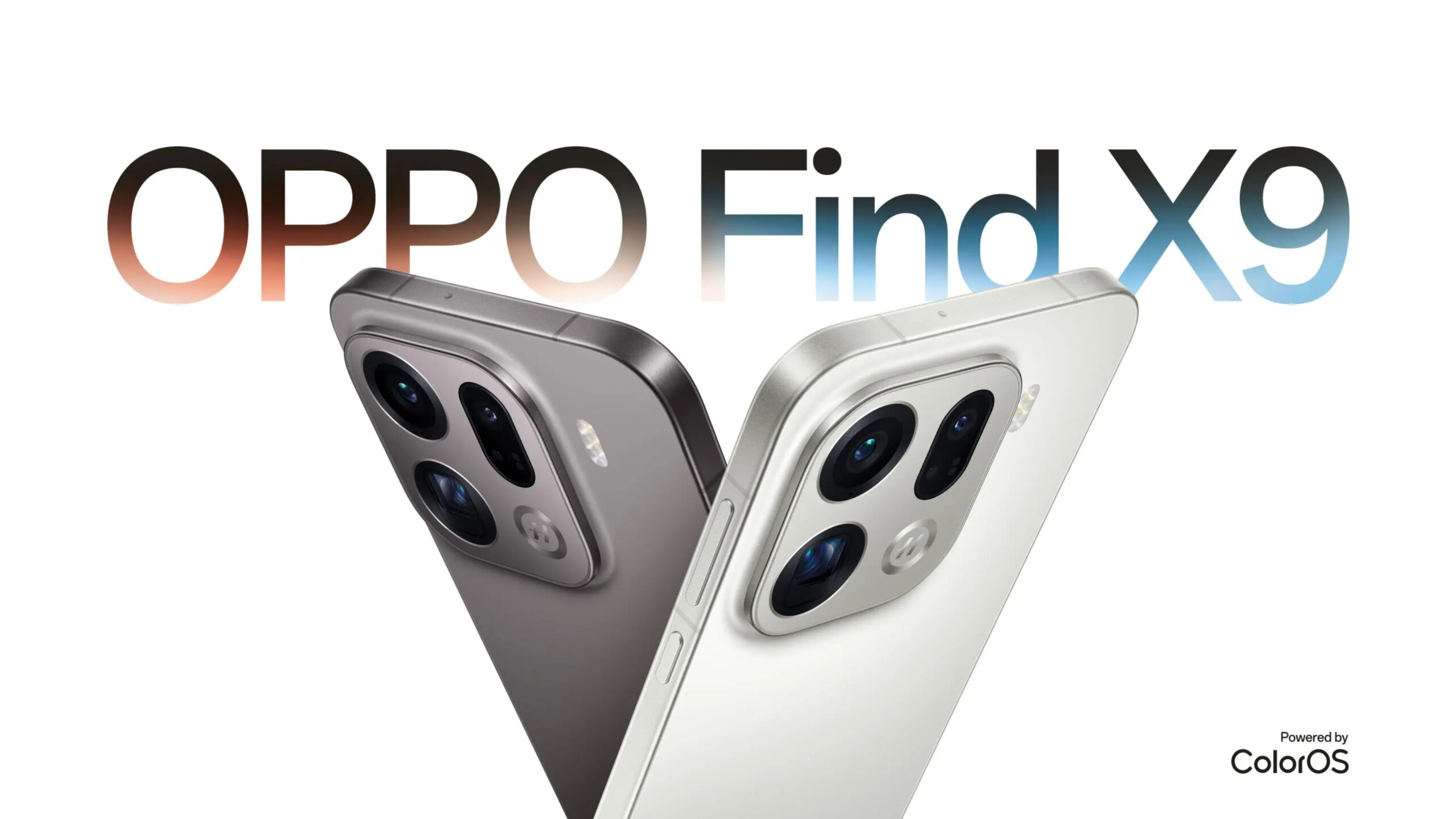
I find (no pun lost here) the new Find X9 Pro to be OPPO’s most accomplished flagship yet. This isn’t just another incremental upgrade. The Find X9 Pro represents a genuine leap forward in battery life and mobile photography, backed by hardware and software that actually deliver on their promises.
What immediately struck me right after I unboxed the device is how OPPO has managed the impossible: fitting a massive 7500mAh battery into a remarkably slim profile. This is undoubtedly a two-day battery phone. But the highlight is that it still feels like a sleek flagship, not a bulky power bank.
The build quality is exceptional throughout. Every physical element, from the precisely engineered buttons to the refined camera housing, screams premium craftsmanship and efficient engineering. This is a phone that focuses on excellence in imaging while refusing to compromise on the essentials: battery life, display quality, and day-to-day performance.
Premium & Purposeful Design Language
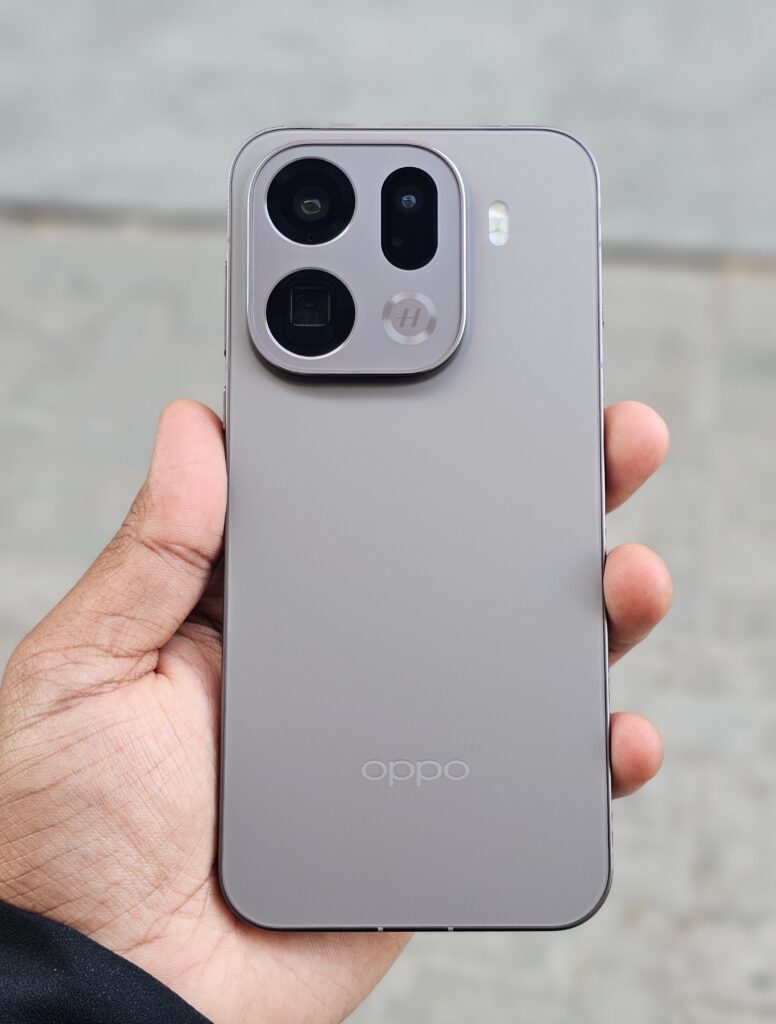
The Find X9 Pro introduces a refined design language characterized by neatly rounded corners and a balanced form. I’ve been using the Titanium Charcoal variant, which features a deep, muted tone with a non-reflective matte texture. It conveys both durability and modern elegance while resisting fingerprints effectively. The flat-edged aesthetic with subtle frame contours ensures a secure and comfortable grip. At 8.25mm thin and 224g, it strikes a perfect harmony between sophisticated elegance and everyday functionality. Even encased in the included case, the phone doesn’t feel hefty or uncomfortable to hold.
The build quality is exceptional throughout. Every physical element feels thoughtfully crafted. The buttons have a satisfying, precise click with no wobble or mushiness. The rear camera module, positioned in the top-left corner, aligns perfectly with the frame. This thoughtful engineering translates to superior ergonomics: when holding the phone vertically my index finger naturally avoids the lenses, and grip remains clear for landscape gaming or media.
These details might seem minor, but they collectively create a device that becomes invisible in the best way possible. Not because you forget it’s there, but because it integrates so naturally into your life that using it feels effortless, always ready for whatever you need without demanding attention.
Two New Physical Buttons
The Find X9 Pro introduces two new physical buttons that enhance functionality, and both are evidently super-high-quality in their execution:
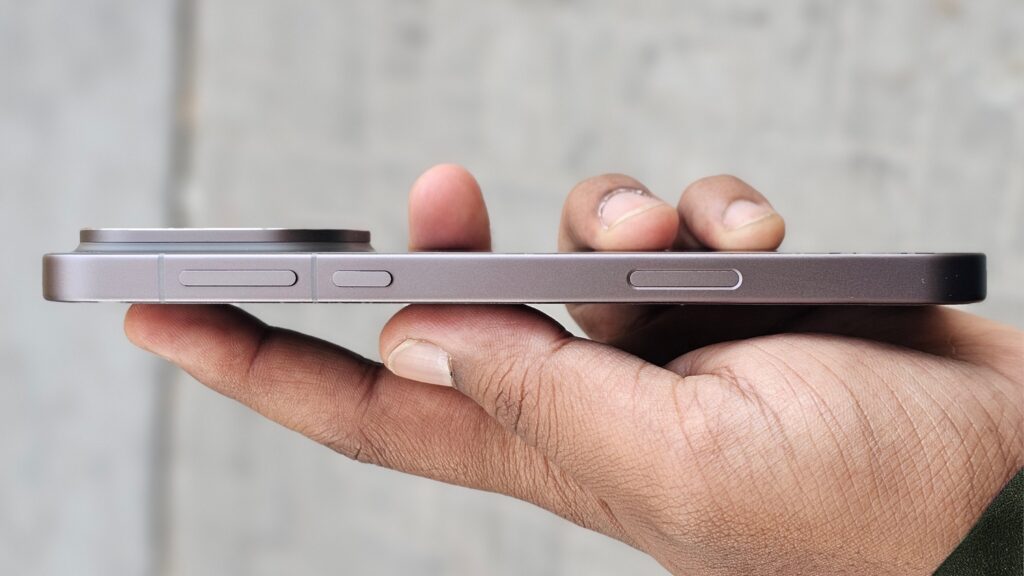
Snap Key: Integrated into the left frame, this customizable button allows you to assign functions like switching sound profiles, toggling the flashlight, launching voice recorder, activating translation, or taking screenshots. By default, it’s linked to the AI Mind Space feature: short-press captures screen content, long-press adds a voice note, double-press opens Mind Space directly. The tactile feedback is excellent, with a definitive click that feels premium.I’ve customized mine to quickly toggle between silent, vibrate, and ring modes, a feature I’ve genuinely missed since physical alert sliders fell out of fashion.
Quick Button: On the right side, OPPO has added a Quick Button, which I initially mistook for a physical fingerprint scanner. However, it is a quick-toggle/physical zoom control for the camera. Double-tap opens the camera, press to take a photo, long-press for continuous shooting. In landscape orientation, you can swipe on the button to zoom in and out. The button has a satisfying half-press for focus (like a DSLR shutter button) and a full press for capture. This is genuinely useful for quick camera access and adds tactile control that feels more intuitive than the on-screen zooming-wheel.
IP69: Built to Last
The Find X9 Pro provides comprehensive protection with IP66, IP68, and IP69 certifications. The IP68 certification, which is normal for current flagships, guarantees proven protection against dust and prolonged water submersion (up to 1.5 meters for 30 minutes). However, on top of that, the Find X9 Pro gets an IP69 rating which provides defense against high-pressure, high-temperature water jets (up to 85°C), ensuring the device can withstand more extreme conditions.
I’ve used the phone by the pool, in the kitchen and in similar splash-prone environments without any hesitation. The peace of mind that comes with this level of protection is invaluable.
A Display That Demands Attention
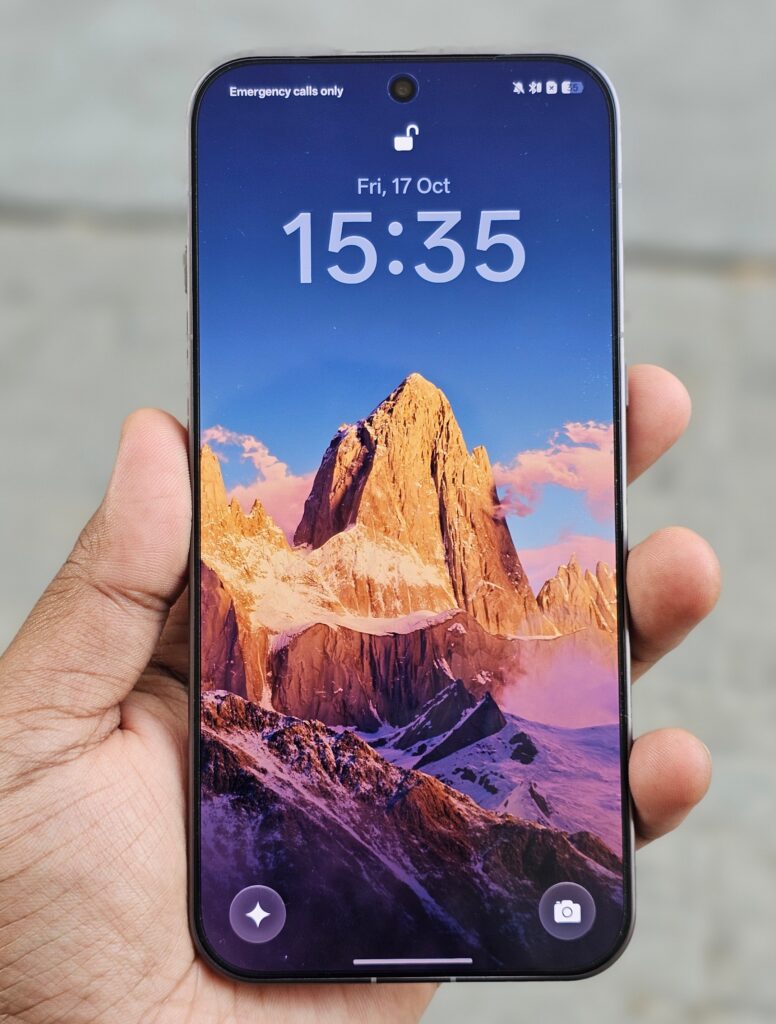
The 6.78-inch AMOLED display is surrounded by ultra-narrow bezels measuring just 1.15mm on all four sides. This is the thinnest bezel on any OPPO phone, creating a truly seamless viewing experience that minimizes visual interruptions.
The display’s peak outdoor brightness of 3600 nits is seriously impressive. “Nits” measure screen brightness, and 3600 is among the brightest available. In Dubai’s harsh sunlight, I can read the screen comfortably without any strain or need to cup my hand over it. The 1-120Hz LTPO refresh rate means the screen intelligently adjusts its update frequency based on content, delivering buttery-smooth scrolling when needed while conserving battery when displaying static content.
Super-Comfortable for Afterdark Usage
Traditional displays flicker rapidly to control brightness, and this flicker, while invisible to most people, can cause eye fatigue over time. The Find X9 Pro’s 2160Hz PWM dimming flickers so rapidly (2,160 times per second) that it essentially eliminates perceptible flicker, making it genuinely comfortable for extended nighttime use. I frequently use my phone in bed, and the combination of ultra-low brightness and flicker reduction makes a noticeable difference in eye comfort.
Possibly The Fastest Fingerprint Unlock I’ve Ever Experienced
Optical vs Ultrasonic Fingerprint Scanners
Here’s the difference: optical fingerprint scanners (found on most phones) work by shining light on your finger and taking a photograph. They create a 2D image of your fingerprint, which can be fooled by high-resolution photos and struggles with wet or oily fingers.
Ultrasonic scanners use high-frequency sound waves (like sonar or bat echolocation) to map the 3D ridges and valleys of your fingerprint. The scanner emits ultrasonic pulses, which bounce off your fingerprint’s unique topography. By measuring the reflected waves, it creates a highly accurate three-dimensional map of your fingerprint.
The 3D ultrasonic fingerprint scanner of the Find X9 Pro deserves special recognition because it’s genuinely the fastest and most reliable biometric unlock I’ve experienced on any smartphone. Not just among optical sensors, but even when compared to the pioneering ultrasonic implementations from competitors. The recognition is instantaneous. There’s virtually no perceptible delay between touching the sensor and the phone unlocking. It feels less like authentication and more like the phone simply recognizing your existence.
What’s equally impressive is the registration process. Most phones require you to tap your finger multiple times in the same position, slowly building up a complete fingerprint map. The Find X9 Pro’s approach is far more elegant: one press, then simply move your finger around naturally to register all parts. The sensor captures your entire fingerprint topology in one fluid motion. The whole process takes seconds rather than the tedious minute-plus routine I’ve experienced with other devices.
ColorOS 16: Refined Software Experience
Running ColorOS 16 based on Android 16, the software experience is polished and feature-rich. every interaction now feels instantaneous and perfectly connected. The transitions from Always-On Display to lock screen to home screen flow in one continuous, graceful motion. The wallpaper doesn’t just appear, it elegantly transforms through each stage. I’ve found myself unlocking the phone just to watch this seamless transition. It’s the kind of refined detail that elevates the entire experience from functional to genuinely delightful.
OPPO’s Luminous Rendering Engine powers all of this visual magic. It renders all visual components in parallel, eliminating jarring transitions and ensuring the OS stays perfectly smooth no matter how much is happening on screen.
Beyond the visual flourishes, ColorOS 16 brings genuinely useful features. The Flux Home Screen allows you to resize app icons and folders dynamically, with the surrounding layout adapting fluidly. The result is a system that feels responsive and fluid throughout extended use.
A Camera System That Actually Earns Its Hasselblad Badge
Let’s address the elephant in the room: smartphone marketing loves to throw around buzzwords. But the Find X9 Pro’s Hasselblad Master Camera System isn’t just branding, it’s a legitimately engineered imaging system that genuinely makes use of the extent of what’s possible with a smartphone camera.

Flagship Performance in Any Light
The all-new Ultra XDR Main Camera, consists of a large 1/1.28-inch custom Sony LYT-828 sensor. For me, sensor size matters over the megapixel count, because larger sensors capture more light, resulting in brighter, clearer images, especially in challenging conditions.
Dynamic range is essentially the camera’s ability to capture detail in both the darkest shadows and brightest highlights simultaneously. The Find X9 Pro’s 17 stops actually surpass dedicated 1-inch sensors found in some compact cameras. In practical terms, this means when you’re photographing a sunset, you can see detail in both the bright sky and the darker foreground. No more choosing between an overexposed sky or an underexposed subject.
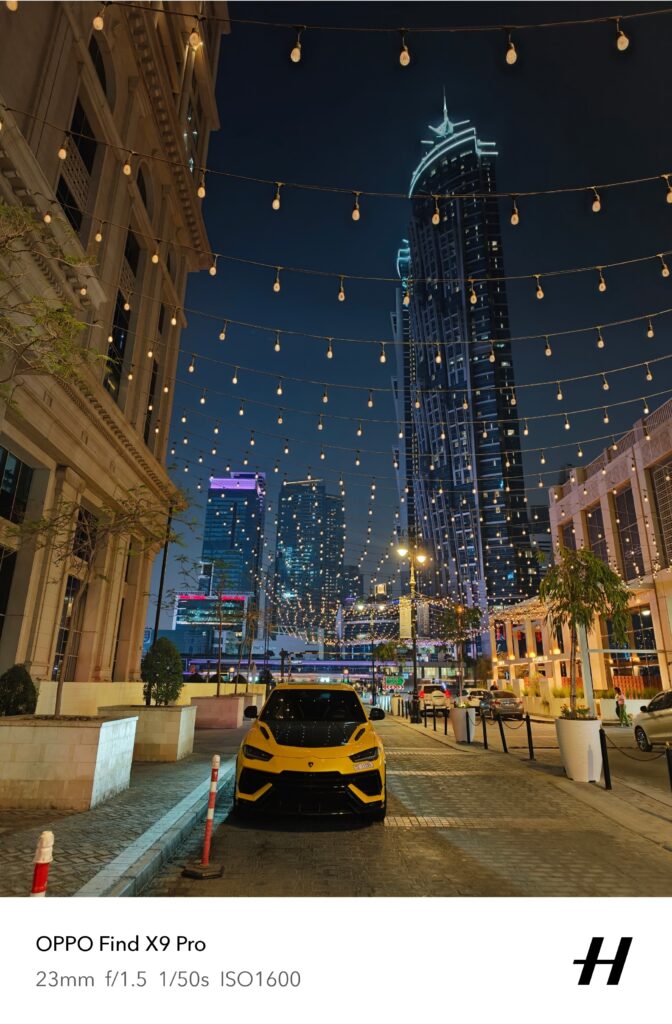
I’ve tested this extensively in Dubai’s harsh lighting conditions: bright midday sun, deep shadows under buildings, sunset shots with extreme contrast. The main camera consistently delivers balanced, natural-looking photos with detail preserved throughout the entire frame.
The 50MP ultra-wide camera (15mm equivalent) is far more capable than the typical afterthought ultra-wide modules found on many flagships. The Samsung ISOCELL JN5 sensor delivers genuinely impressive image quality across the frame, with minimal distortion at the edges and excellent detail retention even in the corners.
What sets this ultra-wide apart is the autofocus capability with a minimum focal distance of just 3.5cm. This transforms it into a capable macro camera for extreme close-ups of small subjects like flowers, insects, or intricate details. The 50MP resolution means you can crop in significantly while maintaining sharpness, giving you additional framing flexibility.
200MP 120x Telephoto Shooter
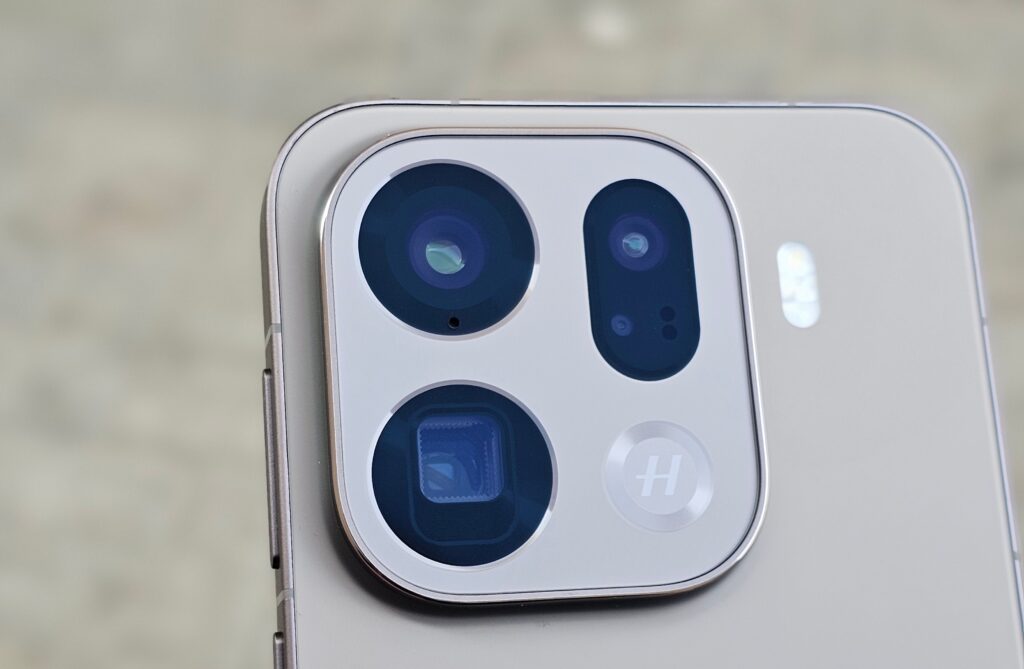
Another standout star here is the 200MP Hasselblad Telephoto camera. Now, 200 megapixels sounds like a spec-sheet flex, but here’s why it actually matters: this isn’t just about capturing massive files. It’s about maintaining exceptional clarity at zoom ranges that would reduce most phone cameras to a mushy mess.
Think of it this way: the Find X9 Pro’s 200MP sensor is like having an ultra-high-resolution master file. When you zoom to 3x (70mm), you’re using the full optical system. At 6x, you’re still getting a native 50MP image by cropping from that massive sensor. Even at 13.2x, the phone delivers a lossless zoom, maintaining detail that rivals dedicated cameras.
I’ve tested this extensively at concerts, sporting events, and even photographing birds from my balcony (yes, I’ve become that person). The clarity at 6x and 10x zoom is genuinely impressive. Details that would be lost on other phones remain sharp and usable.

The True Color Camera: Accurate Colors in Any Lighting
Most smartphone cameras struggle with color accuracy in mixed or unusual lighting. Ever noticed how photos taken in warm cafe lighting look overly orange, or how neon signs at night never quite look right? That’s because traditional cameras make educated guesses about color temperature based on limited information. This is the issue the Find X9 Pro’s True Color Camera solves. This isn’t a camera you shoot with directly. Instead, it’s a dedicated 8-channel spectral sensor with 2 million spectral pixels that acts as a “color consultant” for the entire camera system.
In my testing, this makes a noticeable difference in portraits and in any situation with complex lighting scenarios. Skin tones, in particular, look more natural and consistent across different lighting conditions. I’ve taken portraits in everything from harsh sunlight to dim restaurant lighting, and the color accuracy remains impressive throughout.
Exceptional Night Photography: When Darkness Becomes Your Canvas
The Find X9 Pro’s low-light photography deserves its own spotlight because it genuinely excels where most smartphones struggle. Night photography has always been the great separator between good and exceptional camera systems, and the Find X9 Pro firmly plants itself in the latter category.
The combination of the large main sensor, f/1.5 aperture, and Real-Time Triple Exposure technology delivers exceptional low-light performance. That f/1.5 aperture captures 30% more light than the previous generation, which translates to noticeably brighter and clearer night shots with significantly less noise.
I’ve extensively tested night photography across Dubai’s diverse evening landscapes: dimly lit alleyways, neon-soaked streets, and the challenging mixed lighting of outdoor cafes and restaurants. The results consistently impress. Where other phones would produce grainy, muddy images or over-process scenes into unnatural HDR nightmares, the Find X9 Pro maintains natural texture and color while pulling out impressive detail from shadows and highlights.
The True Color Camera’s contribution becomes especially evident at night. Under mixed neon lighting or warm street lamps, most phones struggle with color accuracy, often rendering scenes with unnatural orange or green casts. The Find X9 Pro’s spectral analysis ensures colors remain true to life, even in these challenging scenarios. Skin tones in night portraits look natural and flattering rather than artificially processed.
Perhaps most impressively, the Find X9 Pro manages all this without falling into the trap of making night look like day. Night photos retain their atmosphere and mood while being perfectly usable, which is exactly what exceptional night photography should achieve.
Pro Video Tools for Serious Creators
All cameras, including the front-facing and three rear cameras, support 4K 60fps recording in Dolby Vision HDR. OPPO has fully optimized the imaging pipeline, resulting in enhanced stabilization, more consistent autofocus and auto white balance, and smoother transitions when switching between lenses during recording.
For professional creators, the Find X9 Pro offers true PRO Video mode with full LOG recording capabilities. LOG captures flat, data-rich files ideal for post-production color grading and maximum creative control. The integrated LUT Preview allows you to visualize a final color grade in real-time while still recording with the highest possible dynamic range.
With the main camera and telephoto camera, the Find X9 Pro further supports 4K video at 120fps in Dolby Vision. This is achieved without compromising stabilization, allowing you to shoot high-quality slow-motion footage with exceptional stability. The LOG profile is ACES-certified (the global standard for motion picture color management), meaning the footage will integrate seamlessly into professional workflows.
Two-Day Battery Champ
The Find X9 Pro takes a major leap in battery capacity with a massive 7500mAh cell. This is significantly larger than the Find X8 Pro’s already large 5910mAh. Remarkably, this substantial increase comes with no change in thickness, maintaining a sleek 8.25mm profile. Let me emphasize this: it’s genuinely remarkable how slim this phone feels despite housing what is essentially a powerbank.

Silicon-Carbon Battery Technology Explained
This achievement is made possible by OPPO’s third-generation silicon-carbon battery technology, a tech that has become the new normal in the latest-gen smartphones. Traditional lithium-ion batteries use graphite anodes (the negative electrode). Silicon, however, can hold far more lithium ions than graphite. Silicon has a charge capacity that’s about 13% higher than graphite’s theoretical maximum. Hence it delivers a higher-capacity cell without the added heft.
The massive 7500mAh capacity, paired with the efficient Dimensity 9500 chipset and OPPO’s precise software tuning, enables the Find X9 Pro to deliver an average of two days of typical usage on a single charge. This is undoubtedly a two-day battery phone. I’m a heavy user (extensive photography, video recording, social media, streaming, video calls / virtual meetings) and I consistently get a full day with 30-40% remaining. Moderate users will easily achieve two full days without breaking a sweat.
More importantly, the battery is engineered for long-term durability. The Find X9 Pro is designed to retain up to 80% of its original capacity even after five years of typical use, ensuring consistent performance year after year. You can also set the charging limit anywhere from 80% to 100% based on your needs to further slow battery aging.
With 80W SUPERVOOC wired charging, you can get hours of use in just minutes. And the fact that you get an 80-watt charger in the box is just the cherry on top of this already sweet deal.
Flagship Power, Flagship Efficiency
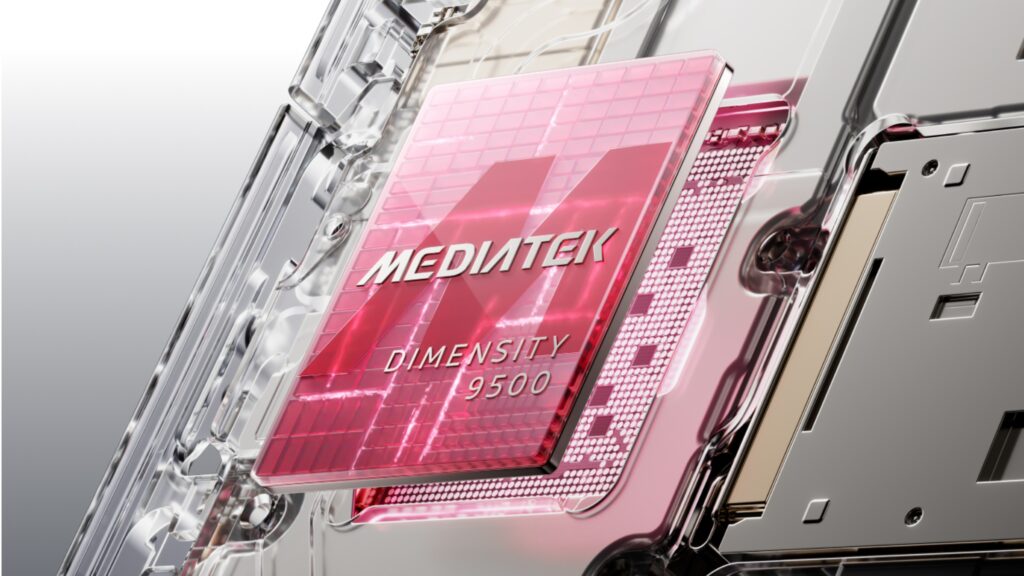
The Find X9 Pro is among the first smartphones featuring the latest MediaTek Dimensity 9500 chipset. Built on TSMC’s advanced 3nm process (smaller manufacturing process means better efficiency and performance), this flagship chip features a third-generation All Big Core CPU design.
This means instead of having slow, efficient cores for basic tasks and fast cores for demanding tasks, all eight cores are performance-oriented. The chipset delivers up to 32% faster CPU performance and 55% more efficiency compared to the previous generation. GPU performance is up to 33% faster with 42% better efficiency. The ninth-generation MediaTek NPU 990 (the AI processor) is 111% faster with 56% improved efficiency.
In real-world use, this translated to the phone being incredibly snappy. Apps launch instantly, multitasking is seamless, and even the most demanding games run flawlessly. I’ve played PUBG Mobile, and Genshin Impact at maximum settings, and the performance is consistently smooth with no lag or stuttering.
Advanced Cooling Keeps Everything Running Smoothly
The Find X9 Pro features an upgraded vapor chamber for thermal management which has been completely redesigned with an ultra-fine 0.025mm stainless steel mesh. This reduces its thickness while significantly improving thermal conductivity for more efficient heat transfer.
The vapor chamber works like an advanced heat pipe: when the phone heats up, liquid inside evaporates and moves to cooler areas, then condenses back into liquid and releases the heat. It’s a continuous cooling cycle that spreads heat evenly instead of creating hot spots.
In my month of testing, even during extended 4K video recording sessions or intensive gaming marathons, the phone gets warm but never uncomfortably hot. The cooling system ensures consistent performance without thermal throttling.
AI LinkBoost Ensures All-Time Seamless Connectivity
OPPO’s AI LinkBoost incorporates OPPO’s self-developed RF chip that boosts uplink power by over 30% in key frequency bands. With advanced 360-degree surround antenna architecture, it significantly enhances signal stability and anti-interference capability.
In practical terms, the phone maintains strong connectivity even in traditionally weak-signal environments like elevators, underground garages, and during high-speed transit. I’ve noticed consistently better signal reception compared to other flagships, particularly in Dubai’s numerous underground parking garages where signal typically drops.
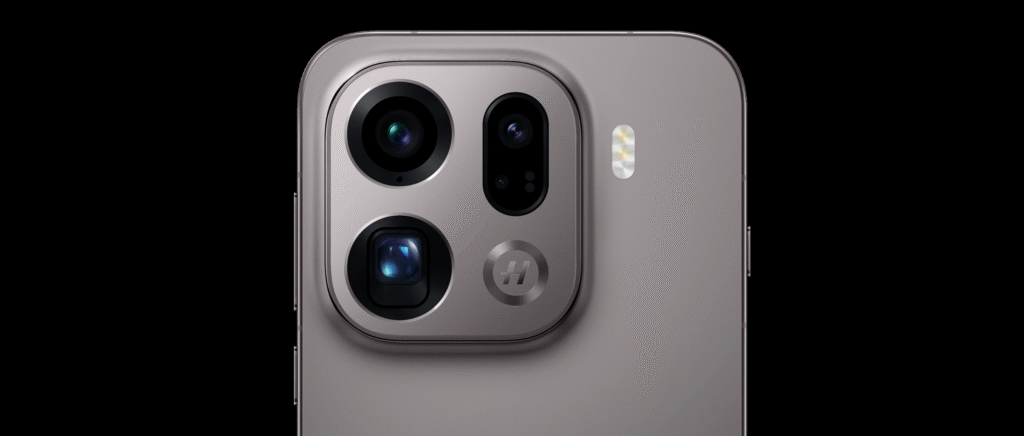
The Verdict
The OPPO Find X9 Pro is a new-generation camera flagship, crafted for the remarkable.
After over a month of real-world use, the Find X9 Pro has exceeded my expectations in virtually every category. This is a phone that delivers on its promises. The 200MP Hasselblad Telephoto isn’t just a spec-sheet flex; it genuinely transforms mobile photography, particularly for zoom, landscape and portrait capture. The main camera delivers flagship-quality images in any lighting condition. The industry-first features like 50MP default shooting aren’t gimmicks; they’re genuinely useful capabilities that enhance the photography experience.
Beyond the camera excellence, the Find X9 Pro refuses to compromise elsewhere. The 7500mAh silicon-carbon battery delivers genuine two-day battery life in a remarkably slim form factor. The Dimensity 9500 delivers flagship performance with excellent efficiency. The advanced cooling keeps everything running smoothly even under sustained load.
The thoughtful additions like the customizable physical buttons, and superfast 3D ultrasonic fingerprint scanner show OPPO’s attention to the complete user experience, not just headline features.
For users who prioritize exceptional imaging capabilities backed by genuine flagship performance, exceptional battery life, endurance, and build quality, the Find X9 Pro delivers comprehensively. This is OPPO at its best: pushing boundaries in mobile photography while delivering a complete, refined flagship experience.
If you’re serious about mobile photography or simply want a no-compromise flagship that excels across the board, the Find X9 Pro deserves serious consideration.
VAR
RØDE EXTENDS REVOLUTIONARY ALL-IN-ONE PRODUCTION CONSOLE RANGE WITH RØDECASTER VIDEO S
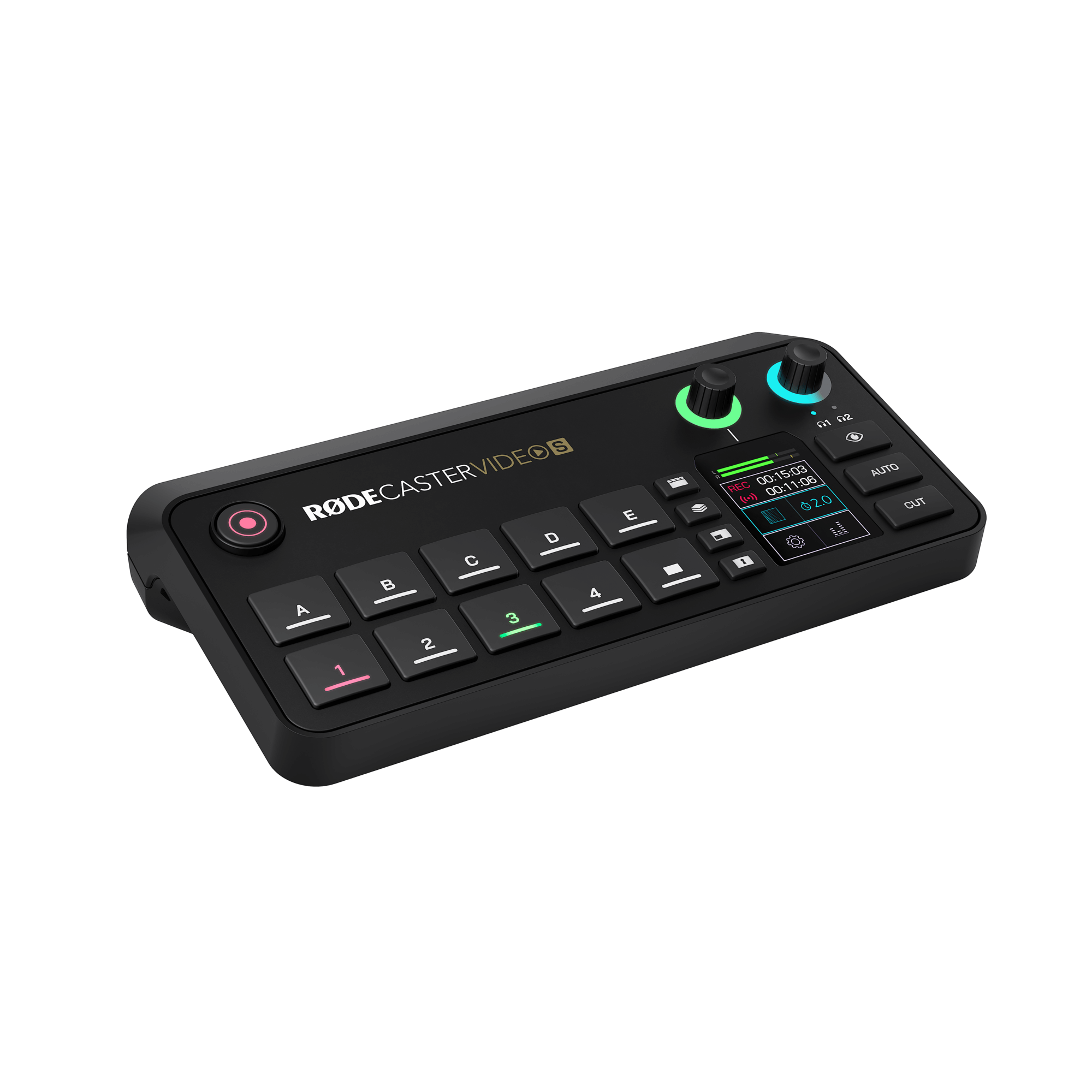
RØDE has today announced the RØDECaster Video S, the latest addition to its revolutionary range of all-in-one video and audio production consoles. Building on the success of the flagship RØDECaster Video, this new streamlined model packs the same powerhouse processing power and broadcast-grade performance as its predecessor into a more compact form factor. Priced at just US$499, it makes professional content creation more accessible than ever for solo creators, video podcasters, and live streamers.
The RØDECaster Video S combines powerful video switching, recording and streaming capabilities with a fully integrated professional audio mixer. With its smaller footprint, it seamlessly fits into more creative workflows than ever before, foregoing the complexity of traditional setups, while retaining the uncompromising performance RØDE is known for. By consolidating every element of video and audio production into a single, user-friendly console, the RØDECaster Video S empowers creators to streamline their process and produce polished, professional content with ease.
“The RØDECaster Video marked a complete paradigm shift in how creators produce video content,” said RØDE CEO, Damien Wilson. “With the RØDECaster Video S, we’re delivering that same power and flexibility in a more compact and flexible format. Today’s creators crave quality, versatility, and simplicity – and the RØDECaster Video S delivers all of that in one ultra-intuitive, value-packed console.”
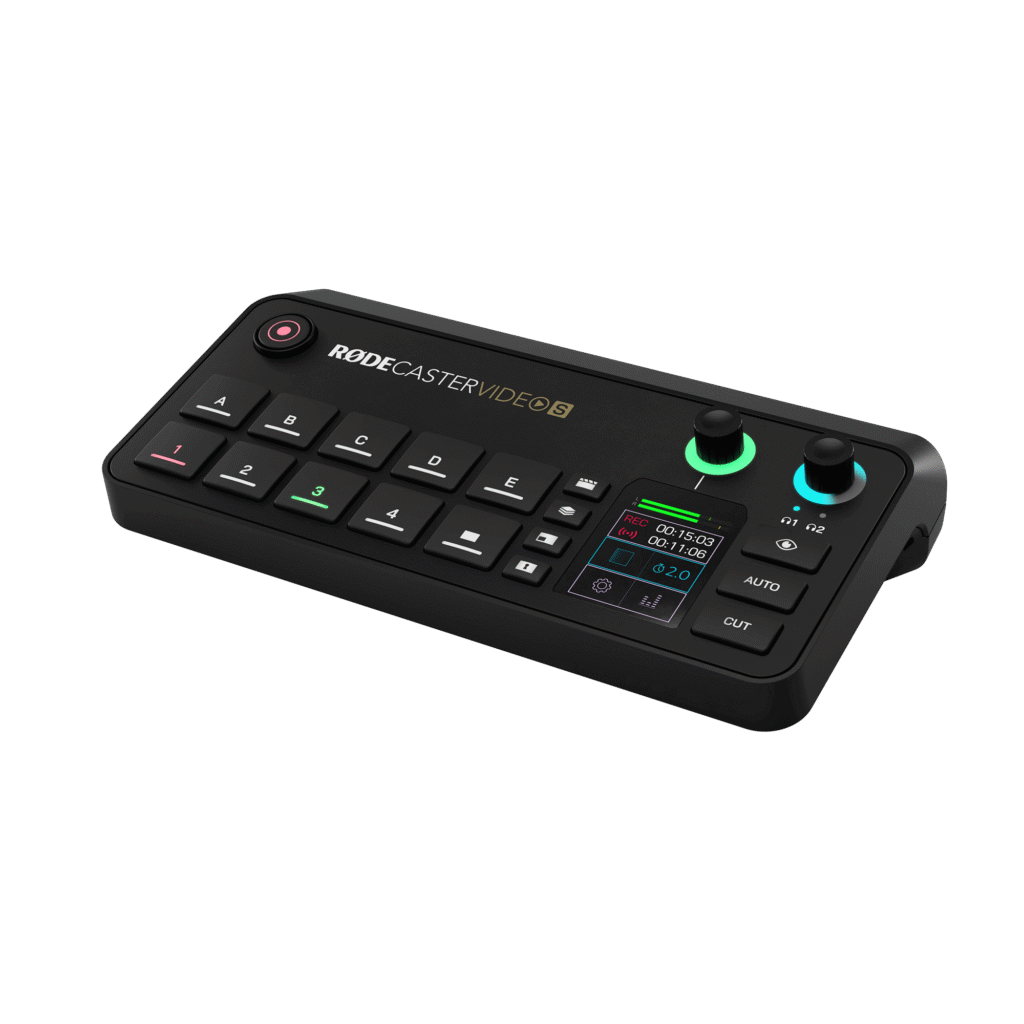
Key Features of the RØDECaster Video S:
- Switch between up to four video sources and five fully customisable scenes at the press of a button
- High-performance octa-core CPU video and audio processor
- Three full HD (1080p) HDMI inputs with auto frame rate conversion and one configurable HDMI output for viewing program, preview and multi-view
- A flexible USB-C port for connecting webcams and RØDE USB audio devices to use as additional video and audio sources
- Two studio-grade Neutrik® combo jacks with ultra-low-noise, high-gain Revolution Preamps™ for capturing pristine audio from XLR microphones, instruments or any other audio source
- Dual internal wireless receivers for connecting RØDE Series IV wireless microphones
- Powerful APHEX® audio processing, including an EQ, compressor, noise gate, high-pass filter, de-esser and the legendary Aural Exciter™, Big Bottom™ and Compellor™ effects
- Support for network cameras (including PTZ operation) with up to four NDI® inputs and one output via Ethernet, plus Dual Cam streaming with the free RØDE Capture app for iOS devices
- 2-inch high-resolution touchscreen and versatile rotary encoder for quick configuration and setting adjustment
- Ability to create five complex scenes with multiple layers of video, media and graphics, which can be saved and triggered at the touch of a button
- Automatic chroma keying for effortlessly replacing backgrounds with media or live video inputs
- Media playback, graphic overlays, keying, transitions and multi-source scene creation all accessible from the front panel
- Innovative “Inspect” feature for quick-and-easy preview and configuration of any input or scene
- Intelligent auto-switching for seamless hands-free switching of video sources and scenes based on audio inputs
- Stream directly to all major platforms via Wi-Fi or Ethernet, or to streaming software via USB
- Record directly to an external USB storage device, including isolated (ISO) recording for post-editing flexibility
- Remote control, user-assignable graphics and media, custom scene building, audio mixing and effects, and other advanced configuration options via the RØDECaster App
- Designed and made in RØDE’s state-of-the-art facilities in Sydney, Australia
YOUR ALL-IN-ONE PRODUCTION PARTNER
Powered by the same high-performance octa-core processor as the flagship RØDECaster Video, the RØDECaster Video S delivers uncompromising quality in a smaller, more desktop-friendly footprint. It features three HDMI inputs and a configurable HDMI output, making it easy to connect and switch between multiple cameras or other external devices. A flexible USB-C input adds even more versatility, allowing creators to integrate additional video or audio sources as their setup evolves.
On the audio side, the RØDECaster Video S is fitted with two Neutrik® combo inputs featuring RØDE’s ultra-low-noise Revolution Preamps™, alongside dual built-in Series IV wireless receivers, and Bluetooth® connectivity for total flexibility – ensuring effortless, pristine sound capture from XLR or USB microphones, wireless systems, or remote guests. Each of the nine stereo audio channels is powered by APHEX® processing to give your sound a professional sheen, including compressors, noise-gates, de-essers and the coveted Aural Exciter™, Big Bottom™ and Compellor™ processors.
STREAMLINED WORKFLOW, INTUITIVE CONTROL
At the core of the RØDECaster Video S is an intuitive scene-based workflow, giving creators hands-on control over every aspect of their production. Four dedicated video source buttons, five scene buttons and four assignable function keys make it easy to trigger video feeds, switch layouts, play media or apply chroma keying with a single press. The high-resolution two-inch touchscreen and versatile rotary encoder offer precise control over transitions, settings and levels, keeping your production smooth, responsive and fully under control.
For solo operators, the RØDECaster Video S includes intelligent auto-switching – an advanced system that automatically switches camera angles based on who’s speaking, delivering dynamic, hands-free video control. Its innovative Inspect feature allows users to preview and configure any input or scene instantly and safely, ensuring seamless transitions and consistent quality while reducing the risk of broadcasting errors. Combined with its Multiview display, the RØDECaster Video S provides complete oversight of your production, keeping every source visible and accessible at a glance.
ELEVATE YOUR PRODUCTION
Whether live streaming or recording for post-production, the RØDECaster Video S integrates effortlessly into any creative setup. Creators can stream directly to YouTube, Twitch and other major platforms via Wi-Fi, Ethernet or USB, or record straight to an external USB drive or SSD with the option to capture every video and audio source independently for maximum flexibility in post-production.
With the RØDE Capture app, creators can instantly turn their iPhone into a high-quality wireless camera – using both the front and rear cameras simultaneously for true dual-cam streaming. This allows a single iPhone to capture multiple angles at once, perfect for interviews, podcasts or solo content where reaction and perspective matter. Combined with full wireless control via the RØDECaster App, it gives creators total freedom to build, monitor and manage their production from anywhere in the studio.
With its sleek, durable design and compact footprint, the RØDECaster Video S strikes the perfect balance of power and portability – built to handle the demands of modern creators while remaining effortlessly simple to operate. Designed and manufactured to RØDE’s exacting standards at its state-of-the-art facilities in Sydney, Australia, the RØDECaster Video S is the ultimate co-pilot for every step of the creative journey.
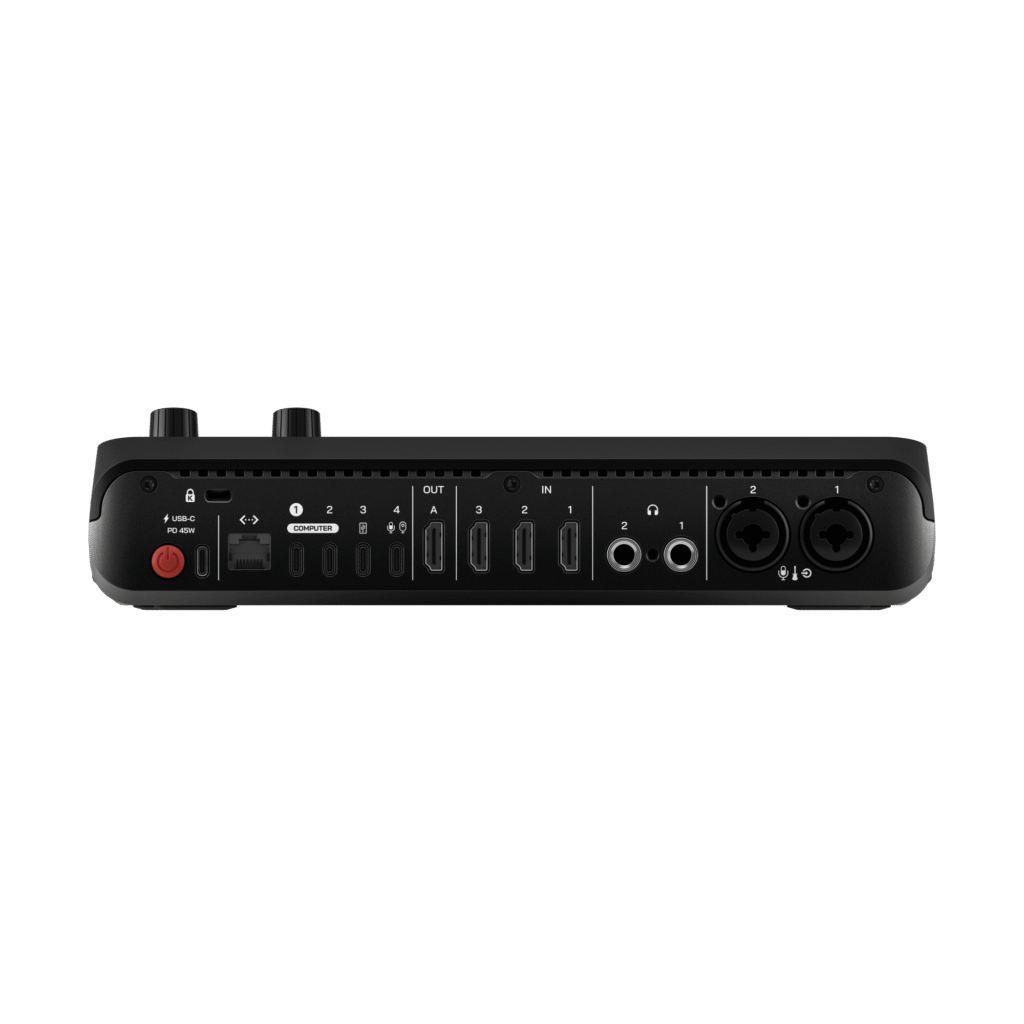
-

 Tech News1 year ago
Tech News1 year agoDenodo Bolsters Executive Team by Hiring Christophe Culine as its Chief Revenue Officer
-

 VAR7 months ago
VAR7 months agoMicrosoft Launches New Surface Copilot+ PCs for Business
-

 Tech Interviews2 years ago
Tech Interviews2 years agoNavigating the Cybersecurity Landscape in Hybrid Work Environments
-

 Tech News4 months ago
Tech News4 months agoNothing Launches flagship Nothing Phone (3) and Headphone (1) in theme with the Iconic Museum of the Future in Dubai
-

 Tech News2 years ago
Tech News2 years agoBrighton College Abu Dhabi and Brighton College Al Ain Donate 954 IT Devices in Support of ‘Donate Your Own Device’ Campaign
-

 Editorial12 months ago
Editorial12 months agoCelebrating UAE National Day: A Legacy of Leadership and Technological Innovation
-

 Cover Story9 months ago
Cover Story9 months agoUnifonic Leading the Future of AI-Driven Customer Engagement
-

 Tech Features1 year ago
Tech Features1 year agoThe Middle East to Lead with Next-generation Mission Critical Communication Advancement












